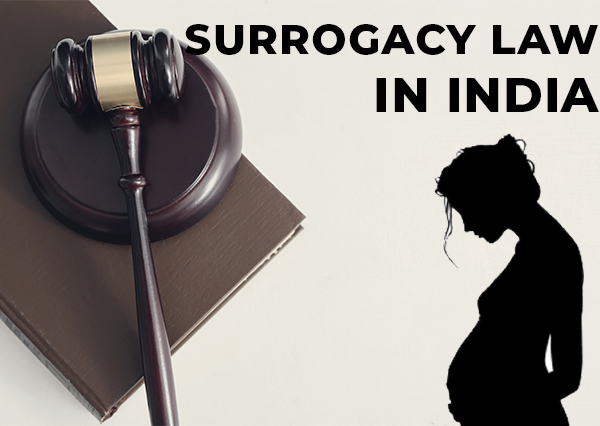Navigating the Legal Landscape of Surrogacy in India
Abstract:
The landscape of assisted reproduction is evolving rapidly, marked by the introduction of two pivotal bills – the Assisted Reproductive Technology (ART) Bill 2020 and the Surrogacy Regulation Bill 2020. While individually addressing key facets of assisted reproduction, a critical examination reveals the necessity for a synchronized and coordinated approach in their implementation. This article explores the imperative need for unified legislation to create a seamless regulatory framework, ensuring comprehensive oversight of assisted reproduction technologies, particularly surrogacy. The coordinated enactment of these bills is crucial to bridge potential regulatory gaps, establish a robust ethical oversight mechanism, protect the rights of all parties involved, and oversee surrogacy practices effectively. The synergy between the ART Bill 2020 and the Surrogacy Regulation Bill 2020 contributes to the creation of a comprehensive regulatory environment, fostering responsible and ethical practices. This article concludes by emphasizing the importance of a unified vision for assisted reproduction, one that advances technology while remaining socially responsible and ethically sound.
Introduction:
Surrogacy, a complex intersection of social, moral, ethical, legal, and scientific facets, has witnessed significant legal scrutiny and evolution in India. This article delves into pivotal judgments that have shaped the surrogacy landscape, particularly the influential cases of Baba Manji Yamada v. Union of India (2009) and Jan Balaz v. Anand Municipality (2008). Furthermore, it explores the proposed Surrogacy Regulation Bill 2020 and the Assisted Reproduction (ART) Bill 2020, evaluating their potential impact on regulating assisted reproduction technologies in India.
The historical trajectory of surrogacy is a rich tapestry woven with the threads of evolving societal norms, groundbreaking medical advancements, legal intricacies, and ethical considerations. Let’s delve into the unique journey that surrogacy has undertaken through the annals of time:
- Ancient Roots (Pre-20th Century): Surrogacy-like arrangements find echoes in the pages of history, tracing back to ancient civilizations. References to women serving as gestational carriers for infertile couples can be found in the cultural narratives of societies such as ancient Rome and Greece.
- Early 20th Century and Artificial Insemination: The dawn of the 20th century witnessed the emergence of artificial insemination techniques, laying the foundational stones for assisted reproductive technologies (ART). While not directly linked to surrogacy, these early developments set the stage for the conceptualization of using a surrogate to carry a child for another couple.
- Landmark “Baby M” Case (1986): The modern landscape of surrogacy was significantly influenced by the highly publicized “Baby M” case in the United States. This legal battle involved a traditional surrogacy arrangement where Mary Beth Whitehead carried a child for William and Elizabeth Stern. Custody disputes ensued, sparking debates on the rights of surrogate mothers and intended parents.
- In Vitro Fertilization (IVF) and the Rise of Gestational Surrogacy: The late 20th century witnessed a revolutionary breakthrough with the development of in vitro fertilization (IVF) technology. This innovation paved the way for gestational surrogacy, where the surrogate carries a child not genetically related to her. This shift addressed ethical and legal concerns associated with traditional surrogacy.
- Legal Frameworks Take Shape: As surrogacy gained prominence, countries grappled with the imperative need for legal frameworks. Jurisdictions adopted diverse stances, ranging from outright prohibition to the formulation of regulated acceptance.
- Surrogacy Tourism and Global Variances: The divergence in surrogacy laws globally led to the phenomenon of “surrogacy tourism.” Intended parents sought surrogacy services in countries with more permissive regulations, underscoring the necessity for international collaboration and standardization.
- India as a Surrogacy Hub (2000s): In the early 2000s, India emerged as a major destination for international surrogacy due to its relatively lenient regulations. However, ethical concerns and issues related to the potential exploitation of surrogate mothers prompted regulatory changes.
- Recent Legislative Shifts: In response to ethical and legal challenges, numerous countries, including India, have enacted or proposed surrogacy laws. These legislative endeavours aim to establish clear guidelines, safeguard the rights of all involved parties, and prevent potential exploitation.
- Ongoing Dialogues and Evolving Practices: The dynamic history of surrogacy reflects continuous debates on matters such as compensation, the nuanced definition of altruistic surrogacy, and the delineation of roles for appropriate authorities. The landscape continues to be shaped by advancements in reproductive technologies, ushering in new ethical and legal inquiries
Important Judgements Shaping Surrogacy Laws:
1. Baba Manji Yamada v. Union of India (2009): A Catalyst for Change The case involves a child born to an Indian surrogate mother for a Japanese couple who faced complications due to their separation before the child’s birth. The Supreme Court of India intervened, ultimately granting custody to the child’s grandmother. This case served as a catalyst for the Indian government to introduce a legal framework regulating surrogacy, recognizing the need for comprehensive legislation to address such complex situations.
2. Jan Balaz v. Anand Municipality (2008): Establishing Identity and Citizenship in Jan Balaz v. Anand Municipality (2008), the Gujarat High Court made a groundbreaking decision. It held that the birth certificate of a child born through surrogacy would carry the name of the surrogate mother. The case gained complexity when the child’s German-national father faced challenges obtaining German citizenship for the child. This judgment not only established the identity of surrogate-born children as Indian nationals but also clarified citizenship matters for such cases.
Analysing Proposed Legislation:
- Surrogacy Regulation Bill 2020: A Multifaceted Approach the Proposed Surrogacy Regulation Bill 2020 aims to bring clarity and structure to the surrogacy process in India. Its multifaceted approach addresses issues of commercial surrogacy, exploitation of surrogate mothers, and the well-being of children born through surrogacy. Key provisions include the prohibition of commercial surrogacy and strict penalties for violations, reflecting a concerted effort to balance the interests of all stakeholders involved.
- Assisted Reproduction (ART) Bill 2020: A Holistic Regulatory Mechanism the Assisted Reproduction (ART) Bill 2020 complements the Surrogacy Regulation Bill, offering a more comprehensive regulatory framework. Encompassing aspects beyond surrogacy, the ART Bill seeks to regulate assisted reproduction technologies as a whole. It sets forth guidelines for ART clinics, aiming to ensure ethical practices, accountability, and standardized procedures. This holistic approach is crucial for the effective governance of various assisted reproduction processes, including surrogacy and abortion.
The Imperative Need for Coordinated Legislation in Assisted Reproduction
In the realm of assisted reproduction, the existence of two distinct bills, the Assisted Reproductive Technology (ART) Bill 2020 and the Surrogacy Regulation Bill 2020, highlights the multifaceted nature of the regulatory landscape. While both bills individually address significant aspects of assisted reproduction, there is a compelling need for synchronized enactment to create a seamless and comprehensive regulatory framework. The synergistic implementation of these laws promises to establish a robust mechanism for overseeing the entire spectrum of assisted reproduction technologies, particularly surrogacy. This coordinated approach is essential to uphold ethical standards, protect the rights of all parties involved, and foster a well-regulated and responsible environment.
1. Addressing the Gaps:
Individually, the ART Bill 2020 and the Surrogacy Regulation Bill 2020 address crucial aspects of assisted reproduction, ranging from the functioning of ART clinics to the specific regulations surrounding surrogacy. However, the possibility of regulatory gaps and inconsistencies arises when these bills operate independently. Coordinated legislation becomes imperative to bridge these potential gaps, ensuring a comprehensive and harmonized approach to the diverse facets of assisted reproduction.
2. Ensuring Ethical Oversight:
Coordinated legislation is vital for establishing a robust ethical oversight mechanism across the assisted reproduction landscape. The ethical considerations involved in assisted reproduction, especially surrogacy, demand a unified and clear regulatory framework. Synchronized implementation of the bills enables the creation of ethical guidelines and standards that apply uniformly, preventing any inadvertent oversight or conflicting regulations that may compromise the ethical integrity of assisted reproductive technologies.
3. Protecting the Rights of All Parties:
The rights of individuals involved in assisted reproduction, including intended parents, surrogate mothers, and children born through these technologies, must be safeguarded comprehensively. Coordinated legislation ensures that the rights of all parties are explicitly defined and protected, leaving no room for ambiguity or potential legal loopholes. This approach establishes a legal foundation that fosters transparency, fairness, and accountability within the assisted reproduction landscape.
4. Overseeing Surrogacy Practices:
Surrogacy, being a nuanced and sensitive aspect of assisted reproduction, requires meticulous regulation. The Surrogacy Regulation Bill 2020, when integrated seamlessly with the broader framework of the ART Bill 2020, provides a specialized focus on surrogacy practices. Coordinated legislation ensures that the unique challenges and complexities associated with surrogacy are effectively addressed, promoting responsible practices, preventing exploitation, and prioritizing the well-being of surrogate mothers.
5. Comprehensive Regulatory Environment:
The synchronization of the ART Bill 2020 and the Surrogacy Regulation Bill 2020 contributes to the creation of a comprehensive regulatory environment. This environment encompasses all stages of assisted reproduction, from the functioning of ART clinics to the intricate processes of surrogacy. A unified regulatory framework streamlines procedures, sets standardized protocols, and facilitates efficient oversight, creating a conducive environment for responsible and ethical practices in assisted reproduction.
6. Facilitating Effective Implementation:
Coordinated legislation not only addresses the theoretical aspects of regulation but also facilitates effective implementation. The integration of both bills allows for the seamless enforcement of regulations, minimizing bureaucratic hurdles and ensuring that the intended goals of the legislation are realized in practice. This approach enhances the efficacy of regulatory measures, making them practical, enforceable, and adaptable to the evolving landscape of assisted reproduction technologies.
Challenges and Controversies in Surrogacy Legislation: Navigating the Delicate Balance
The proposed legislation surrounding surrogacy in India, while well-intentioned, is not immune to challenges and controversies. The intricacies involved in defining altruistic surrogacy, delineating the role of appropriate authorities, and determining reasonable compensation for surrogate mothers present complex areas that may give rise to debates and discussions. Striking a harmonious balance between safeguarding the interests of surrogate mothers, preventing commercial exploitation, and creating a conducive environment for couples seeking surrogacy is a delicate challenge that warrants thorough examination.
1. Defining Altruistic Surrogacy:
One of the primary challenges lies in defining altruistic surrogacy within the legislative framework. Altruistic surrogacy involves a surrogate mother willingly providing her services without monetary gains, typically driven by a desire to assist couples struggling with infertility. The legislation needs to clearly articulate the criteria and conditions that qualify a surrogacy arrangement as altruistic. Ambiguities in this definition could lead to misinterpretations and potential exploitation of the altruistic nature of certain surrogacy arrangements.
2. Role of Appropriate Authorities:
The legislation assigns a crucial role to appropriate authorities in overseeing and regulating surrogacy processes. Determining the composition, powers, and functions of these authorities is essential. The challenge arises in striking a balance between empowering these authorities to enforce regulations effectively and avoiding undue interference in the private affairs of individuals involved in surrogacy arrangements. Clarity on the scope and limitations of authority is vital to prevent overreach or lax enforcement, both of which could undermine the intended regulatory framework.
3. Determination of Reasonable Compensation:
Deciding on reasonable compensation for surrogate mothers is a contentious aspect of surrogacy legislation. On one hand, fair compensation is essential to acknowledge the physical and emotional toll of surrogacy and ensure the well-being of surrogate mothers. On the other hand, excessive compensation may lead to concerns about the potential commodification of surrogacy, raising ethical questions about the commercialization of reproductive services. Striking a delicate balance between fair compensation and preventing financial exploitation requires a nuanced approach within the legislative framework.
4. Balancing Interests and Preventing Exploitation:
A fundamental challenge lies in achieving equilibrium between safeguarding the interests of surrogate mothers and preventing commercial exploitation within the surrogacy landscape. While the legislation aims to curb the potential for surrogacy to become a profit-driven industry, it must also avoid unduly restricting the autonomy and choices of surrogate mothers. Developing a legal framework that respects the autonomy of individuals involved in surrogacy, ensures their protection, and prevents any form of exploitation is a complex task requiring careful consideration of various ethical, social, and economic factors.
5. Creating a Conducive Environment for Couples:
Another layer of complexity involves fostering an environment that encourages couples to seek surrogacy as a viable option without excessive bureaucratic hurdles. The legislation should streamline the process for intended parents, ensuring accessibility and affordability while maintaining the highest ethical standards. Striking the right balance between regulatory oversight and facilitating a smooth, transparent surrogacy process is critical for the success of the legislation and the well-being of all parties involved.
Conclusion:
In conclusion, the legal landscape of surrogacy in India has evolved significantly, driven by influential court judgments and proposed legislative frameworks. The cases of Baba Manji Yamada and Jan Balaz have played pivotal roles in shaping the trajectory of surrogacy laws, emphasizing the need for a structured legal framework. The Surrogacy Regulation Bill 2020, when complemented by the Assisted Reproduction (ART) Bill 2020, holds promise for creating a comprehensive and effective regulatory mechanism.
As India navigates these legal intricacies, it is essential to address emerging challenges, foster public discourse, and ensure that the regulatory frameworks align with the evolving societal dynamics. The proposed legislation, if implemented judiciously, has the potential to strike a delicate balance between the varied interests involved in the surrogacy process, thereby contributing to a more ethical and regulated landscape for assisted reproduction technologies.
AUTHOR NAME- SALONI CHAUHAN, a STUDENT AT-JAGRAN LAKECITY UNIVERSITY, BHOPAL
FAQS
- What are the legal aspects of surrogacy in India?
Surrogacy in India has undergone significant legal changes over the years. Here’s an overview of the legal aspects of surrogacy in India:
-
Regulation: The practice of commercial surrogacy was legal in India until 2018 when the Surrogacy (Regulation) Act, 2019 was passed, which prohibits commercial surrogacy. Only altruistic surrogacy is allowed under the Act, where the surrogate mother can only be a close relative of the intending couple, and no payment can be made to her other than medical expenses and insurance coverage.
-
Eligibility: The Act lays down eligibility criteria for intending couples, including a minimum period of marriage and a medical certificate of infertility. Foreigners, single parents, and same-sex couples are barred from seeking surrogacy in India.
-
Legal Agreements: The Act requires a legal agreement between the surrogate mother and the intending couple, which must be validated by the appropriate authority. The agreement should cover issues related to the surrogacy arrangement, including the welfare of the child.
-
Rights and Obligations: The Act specifies the rights and obligations of the surrogate mother, intending couple, and the child born through surrogacy. It also provides for the custody and parentage of the child.
-
Regulatory Authority: The Act establishes a National Surrogacy Board and State Surrogacy Boards to regulate the practice of surrogacy in India.
-
Penalties: The Act imposes penalties for violations, including imprisonment and fines for engaging in commercial surrogacy or other illegal practices.
-
Ethical Guidelines: The Act also lays down ethical guidelines for assisted reproductive technology (ART) clinics and professionals involved in surrogacy, including the prohibition of sex selection and exploitation of women.
Overall, the legal aspects of surrogacy in India are aimed at regulating the practice to ensure that it is conducted ethically and in the best interests of all parties involved.
What is the Supreme Court decision on surrogacy in India?
The Supreme Court of India has issued several decisions regarding surrogacy in India. One of the landmark cases is the 2008 Baby Manji Yamada vs. Union of India case. In this case, the court addressed the issue of a child born through surrogacy in India to a Japanese couple. The court held that the genetic parents of the child were entitled to take custody of the child and directed the Indian government to issue a travel document to the child so that she could travel to Japan with her parents.
In 2016, the Indian government introduced the Surrogacy (Regulation) Bill, 2016, which aimed to regulate surrogacy in India and prohibit commercial surrogacy. The bill was passed by the Lok Sabha (Lower House of Parliament) but lapsed before it could be passed by the Rajya Sabha (Upper House of Parliament). In 2019, the government introduced the Surrogacy (Regulation) Bill, 2019, which seeks to regulate surrogacy in India and prohibit commercial surrogacy. The bill is currently pending before Parliament.
Overall, the Supreme Court’s decisions and the government’s efforts reflect a growing concern over the regulation of surrogacy in India and the need to protect the rights of surrogate mothers and children born through surrogacy.
3. What are the rules for surrogacy in India 2024?
As of my last update, surrogacy regulations in India were governed by the Surrogacy (Regulation) Bill, 2019. However, the specifics might have changed. In 2019, the bill proposed that only altruistic surrogacy be allowed for Indian citizens, with a ban on commercial surrogacy. It also outlined eligibility criteria for intended parents and surrogate mothers, and established a National Surrogacy Board and State Surrogacy Boards to oversee the process. It’s important to check the most recent legal updates or consult with legal professionals for the current rules in 2024.
4.What is surrogacy Authority of India?
The National Surrogacy Board and State Surrogacy Boards in India were to be established, according to the Surrogacy (Regulation) Bill, 2019. These bodies would have the power to control and monitor surrogacy agreements across the nation.
5. When did surrogacy become illegal in India?
Surrogacy became illegal for foreigners in India in 2015 and for Indian couples in 2019.
https://lawfullegal.in/advanced-certificate-course-in-criminal-litigation/





 2nd CALL FOR PAPERS BY LAWFUL LEGAL FOR THE LEGAL CHRONICLES – ISSUE April
2nd CALL FOR PAPERS BY LAWFUL LEGAL FOR THE LEGAL CHRONICLES – ISSUE April  ABOUT THE JOURNAL – LAWFUL LEGALLawful Legal is a peer-reviewed publication dedicated to exploring and analyzing various…
ABOUT THE JOURNAL – LAWFUL LEGALLawful Legal is a peer-reviewed publication dedicated to exploring and analyzing various…